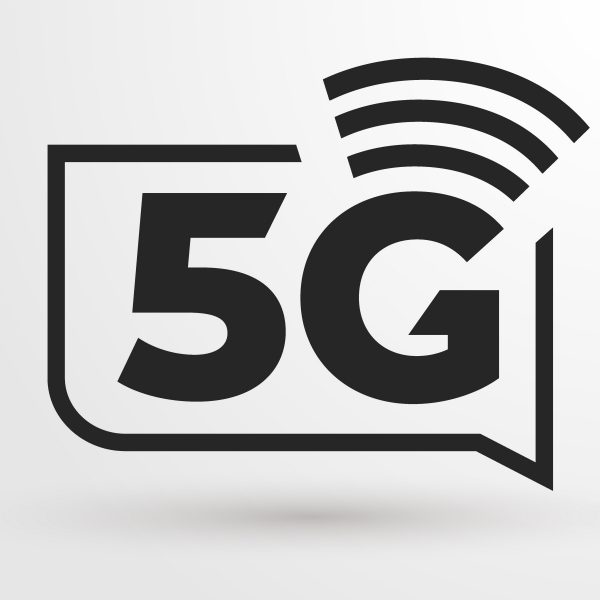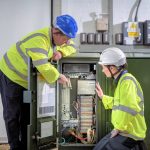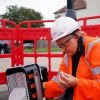Vodafone Claim 5G SA Rollout Across UK Road and Rail Worth £3bn to Economy

Mobile operator Vodafone UK has today claimed, as part of their efforts to build support for a merger with Three UK, that their joint plans for a nationwide roll-out of 5G Standalone (mobile broadband) technology could save regular road users £2bn a year on fuel and boost productivity through remote working on trains by £1bn (GVA) a year.
At present most existing 5G networks in the UK are Non-Standalone (NSA), which means they’re still partly reliant on some older 4G infrastructure. By comparison, 5GSA reflects a pure end-to-end 5G network that can deliver improvements such as ultra-low latency times, faster mobile broadband upload speeds, network slicing capabilities, better support for Internet of Things (IoT) devices, increased reliability and security etc.
Vodafone has already made 5G SA technology available in the “busy areas” of 23 cities and more than 300 locations across the UK, although it’s currently only accessible to customers with supporting devices on their Ultra plans. But the operator has also pledged, as part of their merger with Three UK, to extend the service to more than 99% of the UK’s population by 2034 and push fixed wireless access (home broadband) to 82% of homes by 2030.
Advertisement
The new modelling, which was put together by WPI Strategy, is designed to support all this by using survey data on the working and connectivity patterns on trains to estimate that there could be up to 28.2 million train journeys every year in the UK where people want to work, but don’t due to poor connectivity. Changing this, says Vodafone, could deliver £1bn in extra productivity for the UK economy.
In addition, the survey claims that 5G SA could help to reduce train delays (good luck with that one!), which would save £10m in delay compensation that Vodafone seems to think would magically be “reinvested into critical infrastructure” instead. Similarly, reduced congestion and journey delays for freight drivers thanks to 5G-connected devices on the UK’s roads would equate to productivity savings of £140m per year for businesses in the sector by reducing traffic, making journeys smarter, and deliveries more time efficient.
Alongside the modelling, a new poll of 2,000 UK adults revealed that 60% say poor mobile connectivity on trains stops people using journeys productively – whether to work, catch up with friends or watch a film.
Andrea Donà, Chief Network Officer of Vodafone UK, said:
“The national rollout of a 5G Standalone network has the potential to transform connectivity on the UK’s roads and railways. Across road and rail alone, it could unlock £3bn a year for the UK through boosted productivity and by saving fuel costs through smoother journeys.
Without the proposed merger between Vodafone UK and Three UK, the UK misses out on an £11bn self-funded infrastructure investment to deliver 5G Standalone to 95% of the population by 2030 and 99% of the UK population by 2034.”
At the end of the day, deploying 5G SA more widely and at a faster pace could deliver various improvements, which is something to be both welcomed and encouraged. But we’d caution against accepting the inflated optimism and hype of these anecdotal reports as an accurate reflection of future reality, since in our experience the real-world outcomes are often a lot more modest and harder to quantify.
Advertisement
As we always say, trying to accurately gauge the economic impact of deploying faster broadband or better mobile is notoriously difficult, not least because most people and services won’t be starting from a point of zero connectivity and many of the most common internet tasks (e.g. online shopping, banking etc.) only need a fairly basic connection. Not that better connectivity isn’t needed, but diminishing returns are a factor.
In the case of road and rail users, many of the benefits described above could similarly be delivered if good 4G and regular 5G coverage was improved. However, connectivity isn’t the only problem that is difficult to solve, since trains can still be crowded, bumpy and generally uncomfortable spaces to be working within – 5G SA won’t fix that.
The Competition and Markets Authority (CMA) recently gave Vodafone and Three UK a chance to propose solutions for some of the significant competition concerns that they uncovered with the proposed merger (here). The operators are currently preparing a response to that, which is likely to take the form of several key commitments. If the operators can satisfy the CMA, which seems probable, then there’s a fair chance the deal will be approved.
Mark is a professional technology writer, IT consultant and computer engineer from Dorset (England), he also founded ISPreview in 1999 and enjoys analysing the latest telecoms and broadband developments. Find me on X (Twitter), Mastodon, Facebook, BlueSky, Threads.net and Linkedin.
« Step Telecoms Plans New UK Gigabit Speed Dark Fibre Network























































What exactly are these road transport applications which could save us £2bn/year in fuel, but which cannot operate over 4G or 5G-NSA networks?
Traffic-aware satnav? We have that already.
Even better, you can have traffic aware satnav not using internet at all.
They would say anything to see the merger through !
Liars to the core.
WHy dont they start investing NOW ! They have the funds.
Exactly,if they want to show they want that 11bn ambition after the merger (if it goes ahead) start investing now don’t wait.
The 5G connected car will eventually be 5G mmWave. [Tesla already have the supporting frequencies in USA, but it’s not active yet]
When a good amount of cars have connectivity available we will also need to have smart traffic lights & traffic management to go with it. e.g. traffic lights can change quicker if more cars are seen at one junction opposite the other. There’s already a limited amount of traffic lights that support IoT-M [Machine] but it’s a long way off.
Motorway signs, traffic & pelican crossing lights, road sensors… Things like that.
You don’t need 5G or any other G or cars supporting this. Smart traffic solutions are already in place and everything is connected using fiber optic with cctv. Motorway signs can use 2G to display text.
You will not see any difference with their 5G SA, it will be maybe faster by 50Mbps initially and it will match today’s 4G speeds.
We already do this though — no need for a mobile network to sense the number of cars in a queue
There is also Car2X that is coming in more newer cars, this doesn’t use a mobile connection at all, of course Vodafone will not be mentioning that technology, but ultimately its a lot more reliable, will work everywhere there are cars, and if no cars then its not needed anyway, and no payments required to any mobile phone company.
C2X aka V2X has 5G as requirement, how would you imagine C2X legally exchanging data for more than 100m?
Complete lies. 5G is pretty much pointless unless someone is static. All about pushing for the merger & getting their hands on public funds.
And this is just Vodafone. Same applies to the other networks?
5G is no good when they can’t even make 4G work, mobile router the other day, 3 bars of signal (out of 5), speed: 2Mbps down and 6Mbps up, absolute joke.
Why is Voda 5G SA only available on iPhone 16 when earlier models support it?
lol vodafone can’t even be bothered to bring regular 5G to places that aren’t big cities
Vodafone are waffling utter bullshit trying to convince the regulator to allow the merger with three
First class research. first class comms. bravo Vodafone.
Sent from my iPhone.